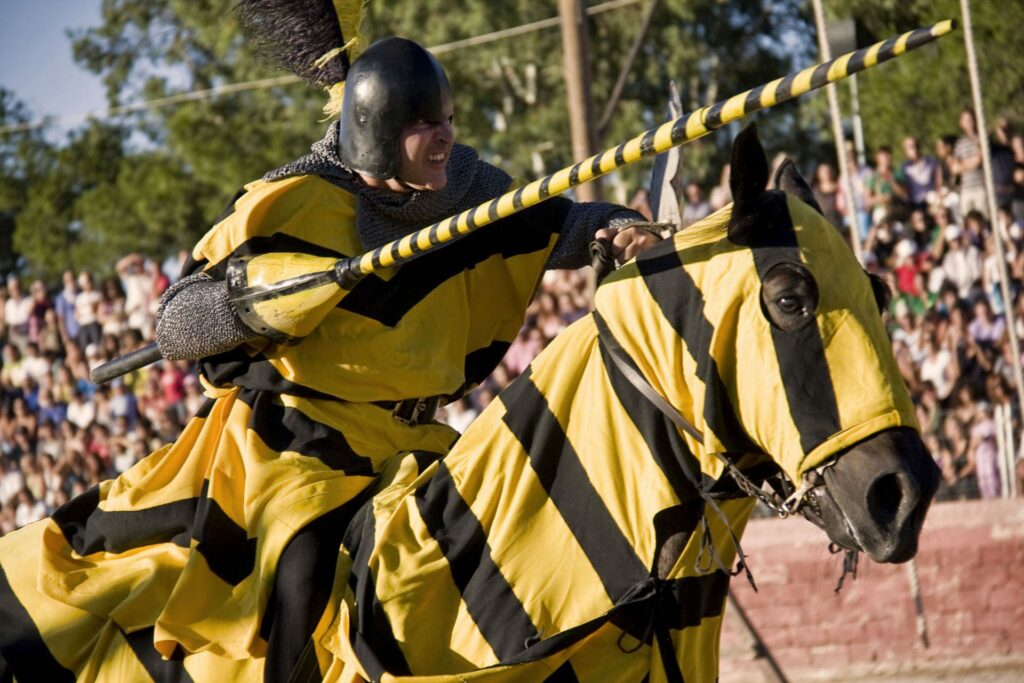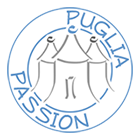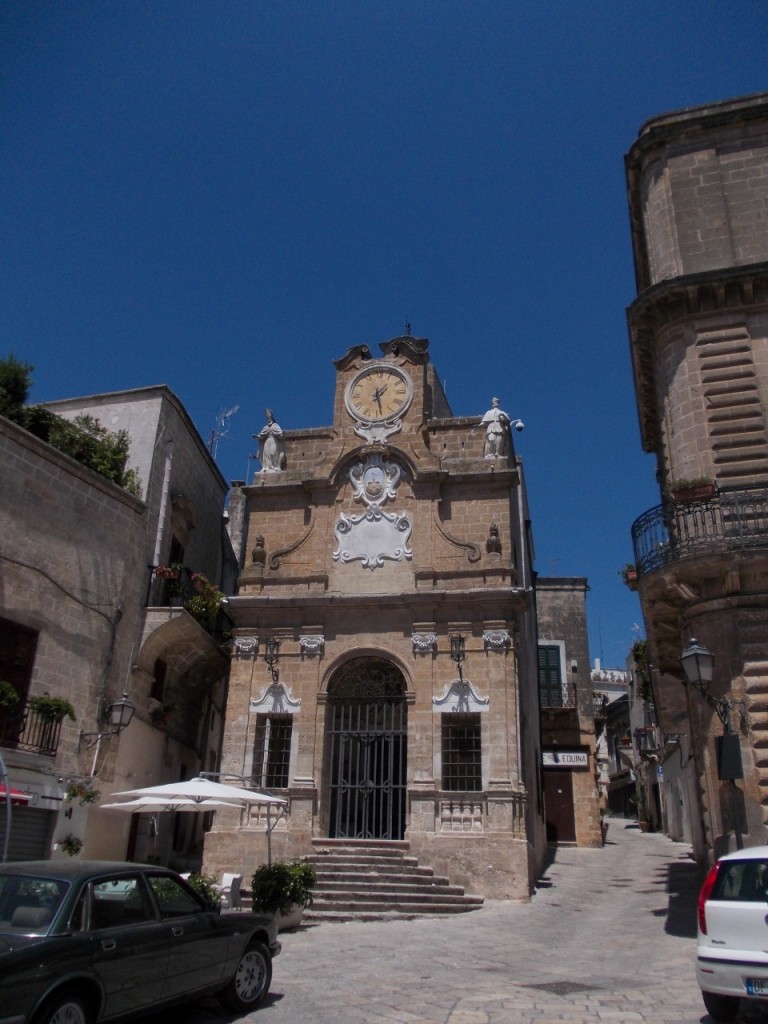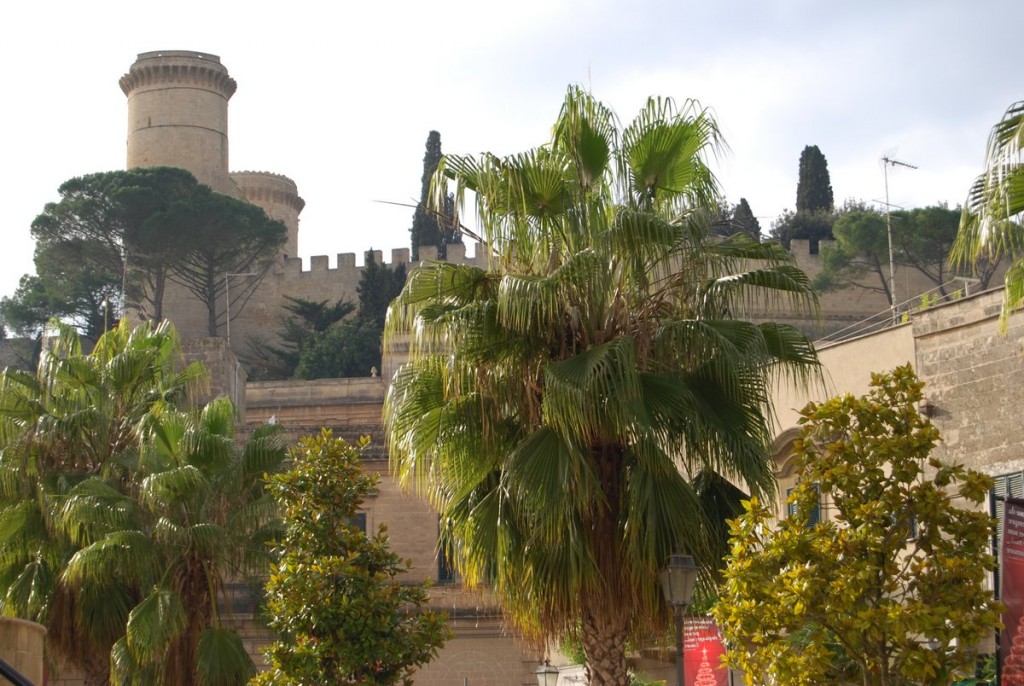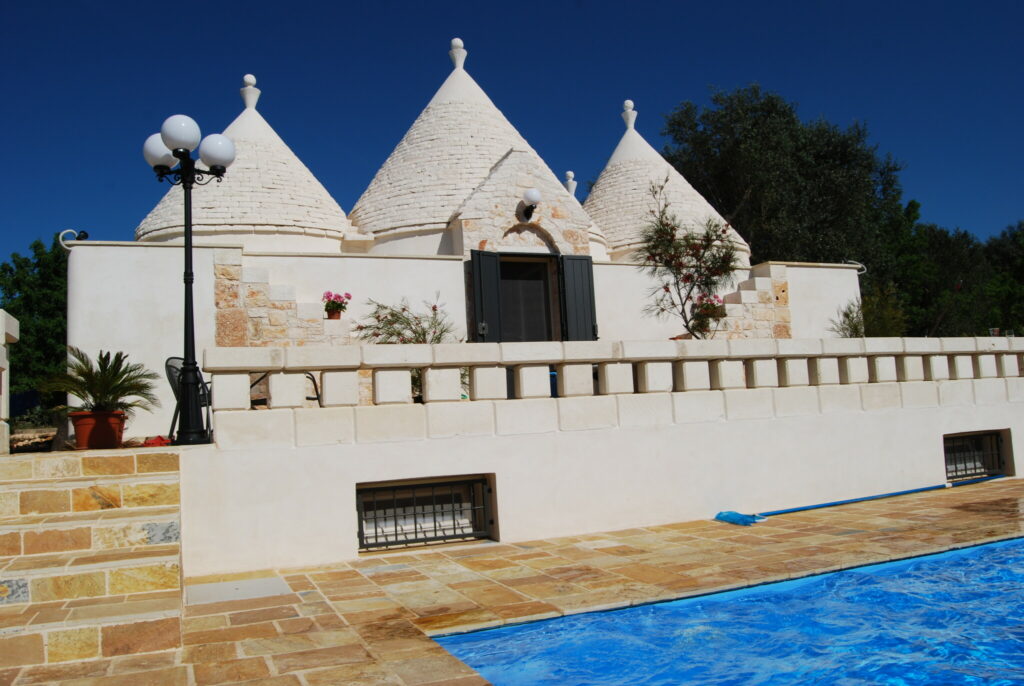


Oria is one of our favourite places in Puglia. We have visted it many times, and definitely recommend it to our guests for its combination of historical, architectural and cultural attractions packed into such a small town. It is easily reached from Ostuni by car and also by rail.
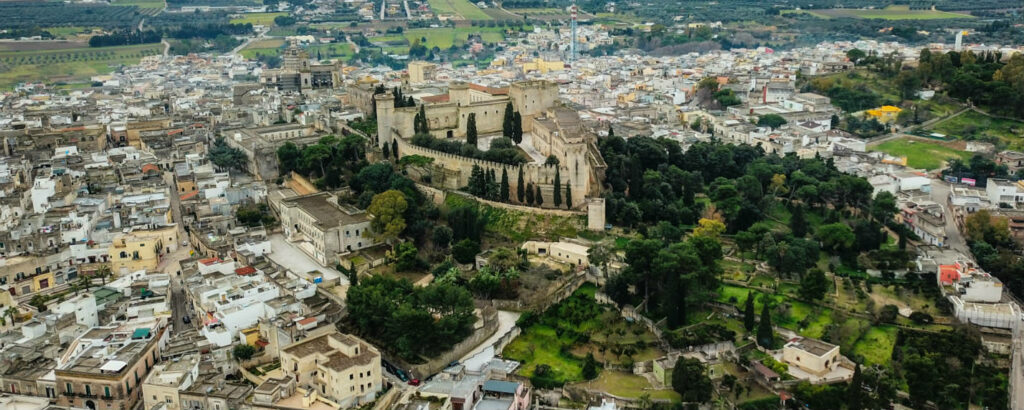
We provide a good deal of detail here on the website as it is not easily available otherwise. The information is divided as follows:
- general background and history of Oria
- some practicalities about visiting - acess, parking, layout, tourist information etc
- the Piazza Manfredi, Corsa Roma, Corso Umberto I and Piazza Lama
- the Jewish quarter
- the cathedral and "mummy museum"
- the castle and its problems
- Parco Montalbano
- the Corteo of Frederick II/Torneo
General background and history of Oria
Oria is built on three adjacent low hills surmounted by the castello and cathedral which dramatically dominate the surrounding plain. It certainly looks like a fortress city as you approach it from any side (including at night when the castle and cathedral are illuminated). Its mediaeval core and unique Jewish quarter provide significant interest. Despite this Oria is not especially well known as a tourist destination. We unreservedly recommend a visit.
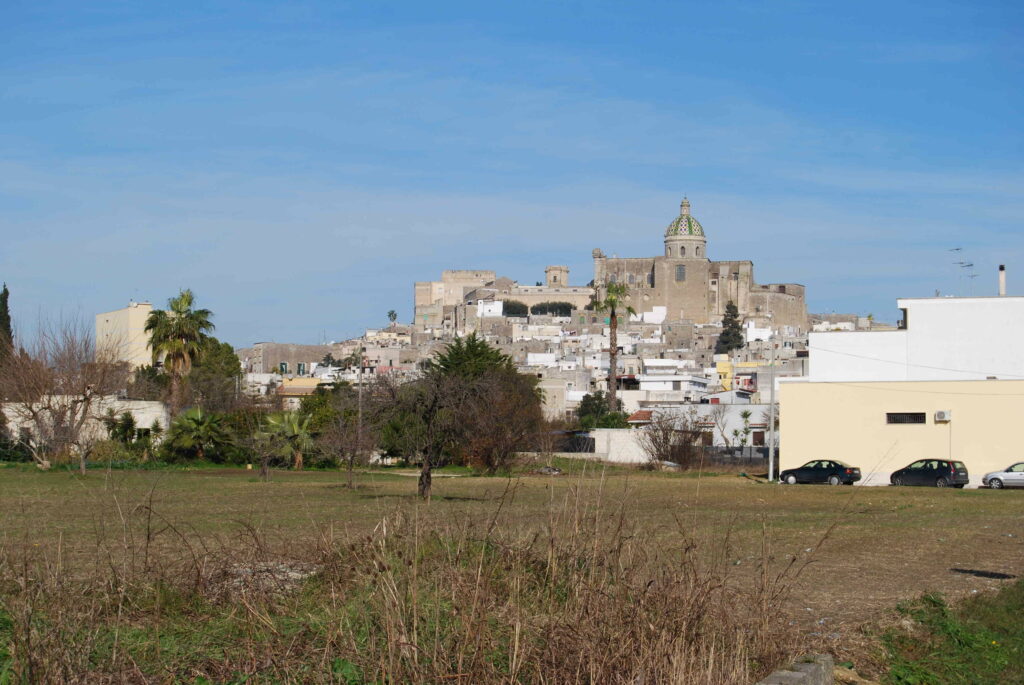
The history of Oria is very much the history of Southern Italy. Originally called Hyria, it was founded by Messapians (one of the groups of Iron Age peoples who settled in Puglia) around 1400 B.C. In 265 B.C. the city became subject to Roman rule. Following collapse of the western Roman empire, it was subject to various rulers including Greeks, Goths, Longobards and Byzantines. In the 9th and 10th centuries AD, there was a significant Jewish settlement.
In 977 Oria was conquered by the Normans, who were succeeded by the Swabians (Sveva). Between 1225 and 1233, the Emperor Frederick II built the castle on a Norman foundation. After the Swabian period, the city was ruled from about 1500 by Angevins and then Spaniards. In 1575 it was purchased by the the rulers of Genoa, and subsequently passed under Bourbon rule from Naples in 1789. In 1860 it became part of the the Kingdom of Italy.
In 1897 it suffered from a severe cyclone which damaged many of its structures.
Practicalities
Oria is easily reached by road. Car parking can be tricky. There are some car parks, but the best option is likely to be street parking just outside the historic centre. Most of this is free but look out for charges in some places. Oria has a station on the main Brindisi - Taranto railway line. The station is just a short walk from the historic centre, so using public transport for a visit is feasible.
Vehicular access to the historic centre is restricted but it is easy to visit on foot. The historic core is defined by a road following the line of original city walls. Pedestrian access inside this road is possible in various places, but the main access points are Porta Manfredi; Porta degli Ebrei; and from Piazza Lama.
Within the historic core, narrow streets radiate from Piazza Manfredi - to the west (left) towards the Jewish Quarter, to the north (Corso Roma) towards Parco Montalbano and Piazza Lama. The best way to reach the castle and cathedral is to follow the street towards the Jewish Quarter and look out for a sign pointing uphill via a steep street and some steps.
The are useful signs and information boards (most of them with a version in English) throughout Oria; and also increasingly displayed codes for the downloading of information. There is an information office situated in Il Sedile, the prominent building in Piazza Manfredi. This is open daily except Mondays, in the morning and sometimes early evening; it is run by an organisation called GAL (which stands for Gruppo Azione Locale) Terre di Primitivo, a promotional body serving Manduria, Oria and 10 other small towns in this part of Puglia which are linked with Primitivo wine. You can obtain a simple but useful leaflet/map from this office, and the staff are very helpful.
Eating and drinking options in Oria are plentiful. There are a few excellent bars and restaurants in and around Piazza Manfredi. We recommend Trattoria Intra Moenia, a few strides from the Piazza on via Castiglione, for excellent quality and good value. We have also had a great lunch in the Oria Vecchia restaurant which is just off the Piazza; full of elegant character and not as expensive as it might appear. On the other side of the city centre, on Piazza Lama, you can have a drink, snack or meal at the Caffe Art Deco', which has the palm trees of the piazza and the castle as a dramatic backdrop.
Piazzi Manfredi, Corsa Roma, Corso Umberto I and Piazza Lama
Porta Manfredi is an obvious main entrance to the central area and leads into Piazza Manfredi, the nearest Oria has to a "hub".
The Porta Manfredi is also known as the Porta Lecce or the Porta degli Spagnoli (the Spanish Gate, so called as it was the entrance used by the Spaniards after a long siege of the city). It was built in 1727. It was originally surmounted by three statues; two of these were destroyed in the 1897 cyclone, the thrird was removed in 1958 because it had become dangerous. It also was decorated with three Coats of Arms, only one of which remains - that of the city of Oria.

The Piazza Manfredi is more like a wide street than a square. It is flanked by a variety of buildings, and several small courtyards and side streets lead off it. The Piazza is the main focus of activity in Oria.
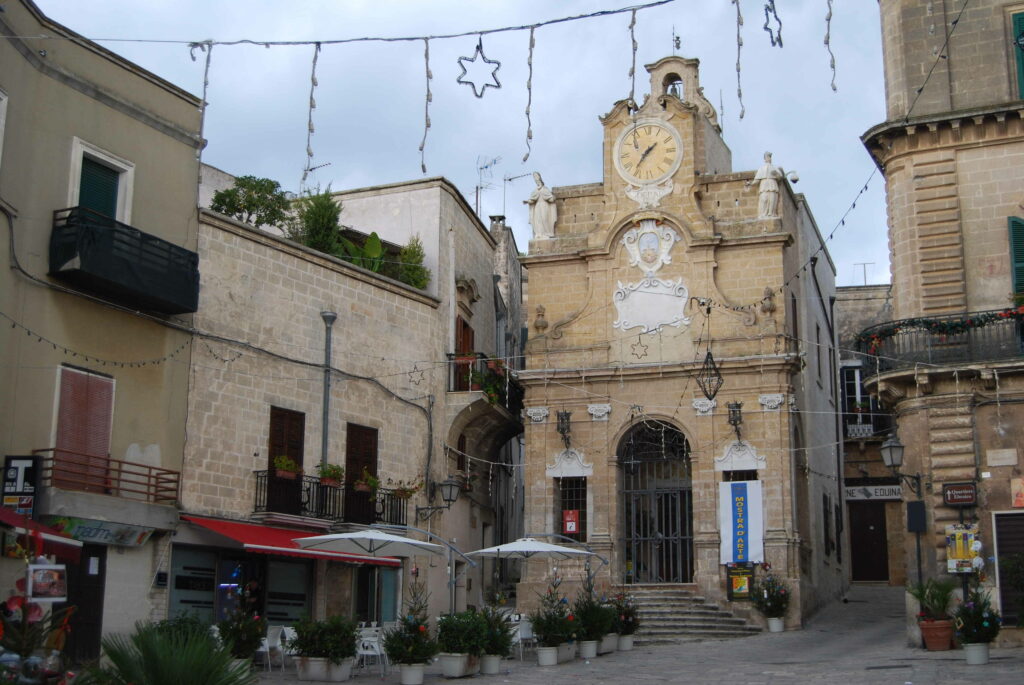
The main building in the Piazza is called Il Sedile ("The Seat"). This was constructed In the 18th century in, in a renaissance and baroque style, to provide a suitably imposing base for the administration of Oria, which was then governed by a local aristocratic family. High on the facade are the statues of St.
Barsanuphius and St. Charles Borromeo, a clock and a civic coat of arms. The building houses a tourist information office, and also is the place for various meetings and events.
From the Piazza, you can walk through the old city to the other side (along Corso Roma and Corso Umberto I, both beautiful narrow thoroughfares, containing various small shops, bars and restaurants. This leads to the Piazza Lama, a modern square with palm trees and sitting areas.
The Jewish quarter
Oria had one of the oldest and most long lived Jewish communities in Otaly. It was established initially in Roman times and survived many ups and downs until 1541 when all of Jews were expelled from the south of Italy. In 925 Oria was pillaged by Sicilian Muslims who wiped out most of the population, including many Jews. The Jewish community was decimated and many of the survivors were forced into slavery. Among them was twelve year-old Shabbetai Donnolo (913-985), who was later bought out of slavery by his relatives in Taranto. He went on to become a famous pharmacist and scholar; his name is celebrated by memorials in his birthplace, Oria.

Although the Jewish community was largely ingtegrated and the religion usually tolerated, this was not always so, and in late mediaeval times people were largely confined to some specific streets. In Oria this occurred under the Angevin Philip II, Prince of Taranto, in the late 1300's. The area is now preserved as the Jewish Quarter. It is actually a number of dead end streets and steps, containing small dwellings; in past times these streets would probably have been gated to prevent the inhabitants mixing with the general populace. One of the houses at the Maddalena Well, at the entrance to Via Francavilla, was recently identified as the site of the synagogue serving the community there. Otherwise. although it is pleasant and interesting wandering around this characterful part of Oria, there is nothing of specific interest to see. It is nevertheless one of the most important reminders of Puglia's historic jewish connections.

The Jewish Quarter can be be entered via the Porta degli Ebrei (Gate of the Jews), also known as Porta Piazzella or Porta Taranto with a large bronze menorah (the traditional Jewish eleborate candlestick) next to it. The gate dates back to the early 15th century and it was rebuilt under Giovanni Antonio Orsini del Balzo, Prince of Taranto, in 1420, then reworked during the Baroque Period and is now surmounted by a late 16th century statue of Santa Maria Immacolata.
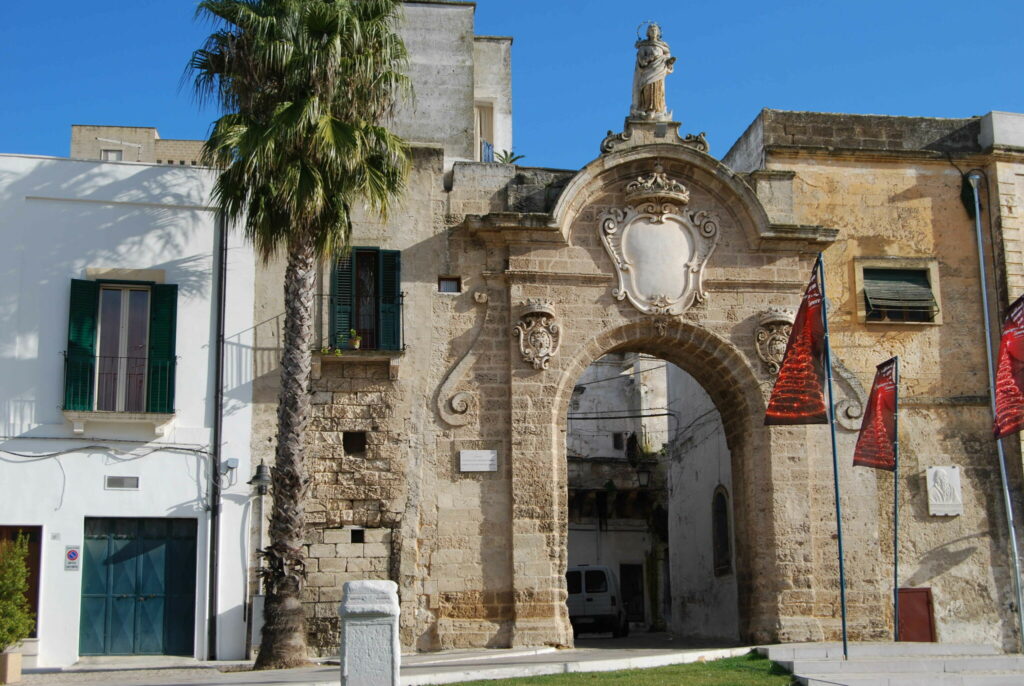
The square in front of the gate is named after Shabbetai Donnolo, and a memorial celebrating this famous mediaeval Jewish scholar, born in Oria, displayed beside the Gate.
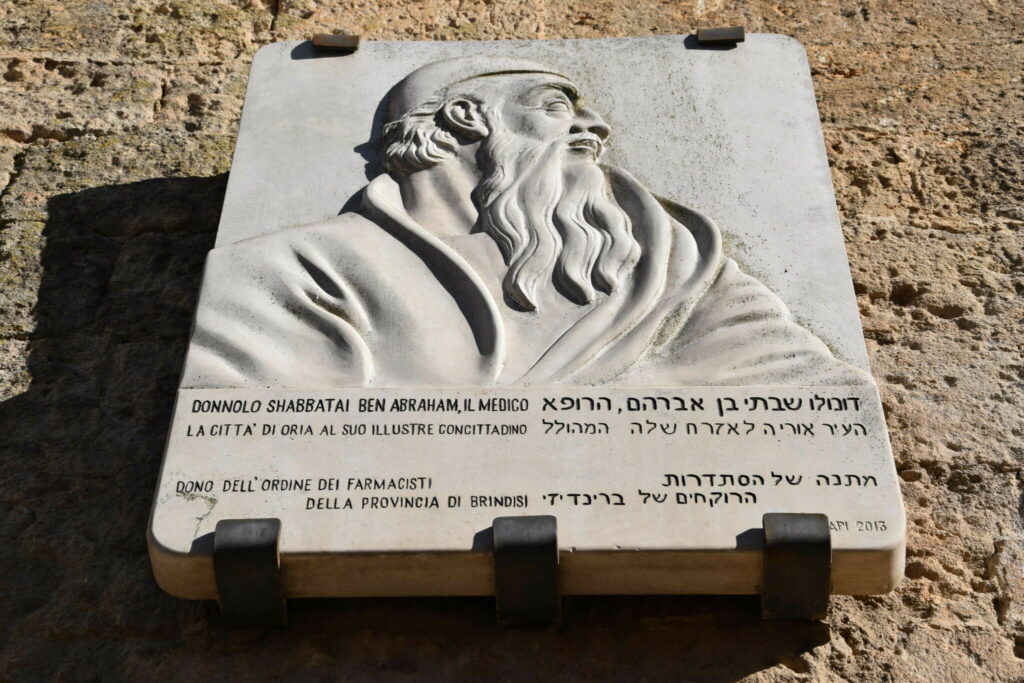
The cathedral and "mummy museum"
The castle and the cathedral of Oria are on the tops of hills above the rest of the historic centre, and are reached by steep streets and steps. These are signposted. Impressive glimpses of the castle and cathedral can be obtained through the narrow streets looking up.

There is a fine view from the piazza in front of the cattedrale, and in reasonable weather you can see both the Adriatic and the Ionian Seas. You can go inside if it is open.
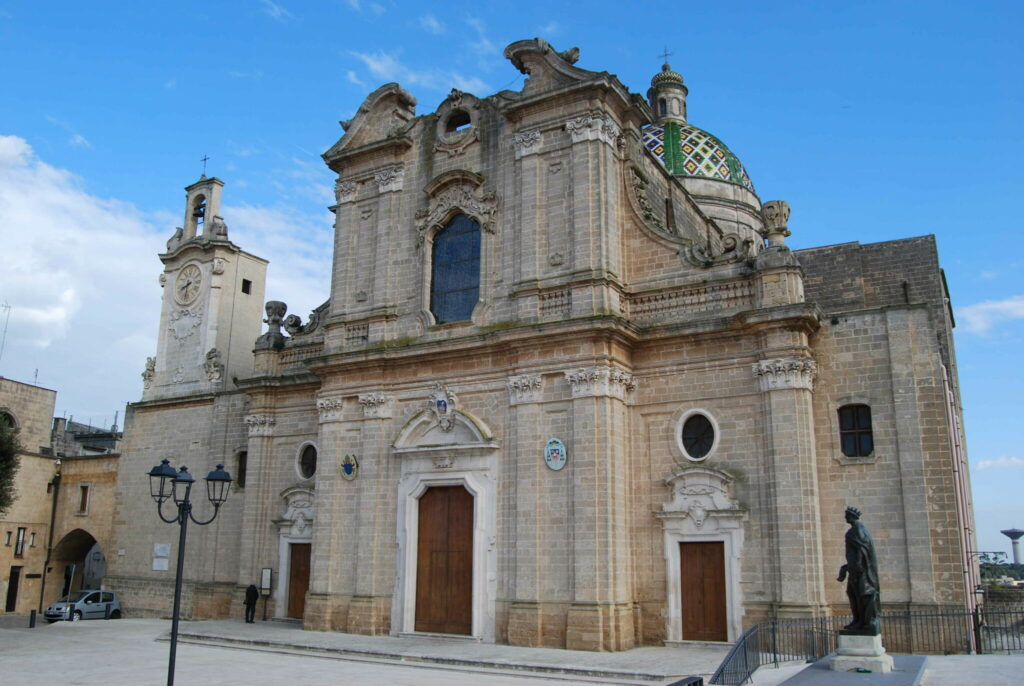
La Cattedrale di Maria Santissima Assunta has been described as a miniature version of St Peter's in Rome. It has a spectacular dome covered in coloured tiles. Internally it has a cross shaped plan with three naves, with significant decoration and works of art.
A staircase inside leads to the Crypt, a major feature of interest in Oria. When it is open (a charge of 2 euros for adults), there are guided tours, including some by English speaking guides. Opening hours are not publicised, so it may well be closed when you go; but well worth a visit if it is open. The Crypt was built in 1484 in memory of all those who had not returned from the battle against the Turks in Otranto. It is a historical museum, but contains the mummified bodies of 11 people, preserved in the last 200 years or so, hence the title Cripta delle Mummie. The mummified bodies are people who chose to be preserved in this way; a long, complicated and expensive process only available to rich families. The mummification was conducted 20-30 times from the 1700s to 1858; 11 remain, a flood having destroyed many of the mummies, but their skulls survived and are displayed above the niches.

The castle
The castello of Ostuni sits dramatically on the top of a hill, surrounded by imposing walls, battlements and gateways. Unfortunately the interior will almost certainly be closed to the public, for reasons xplained below. This photograph courtesy of the Oria Commune gives an idea of what we are denied.

You can reach the main entrance from the cathedral by walking through a few interconnecting streets containing various religious buildings of significance and then you walk up the somewhat encouraging Via Castello towards the gate tower, you will be blocked by an iron gate. Public access to the interior of the castle is not permitted except on rare and poorly publicised occasions.
There is a complicated story attached to this. The castle has always been privately owned, but used to be open for public tours. In 2007, Isabella Caliandro and Joseph Romanin purchased the castle and started a major renovation project apparently aimed at turning it into a conference centre. However, in 2011 the Guardia di Finanza (Finance Police) sequestrated the castle, alleging that the renovations were unauthorised. In June 2013, 12 people including the owners, builders and others were indicted on various charges, covering violation of building codes, abuse of office, fraud against the State and corruption. These accusations have been upheld and we understand that most of the unauthorised changes have been removed, at public expense. Public access was still not allowed. However, in 2013 a local resident successfully used Italy's online public petition system to encourage the authorities to arrange some limited access on specified days, including some days during the August festival. This has been achieved following significant legal proceedings. However, the castle is still owned by the people subject to the charges. According to its own website the castello is closed to the public. Allowed access days are very limited, arranged quite a short time in advance and are not widely publicised. So if you are keen to see inside the castle you will need to undertake some tricky research first. If you visit Oria during the August Corteo, this is likely to provide the best opportunity. Visits involve guided tours in small groups, entry free, but identification is needed for state security reasons.
Recently (April 2024) we have seen reports of some progress in negotiations between the owners and the public authorities. The former are trying to ensure some commercial use of the facility (conferences, receptions etc.), the latter are pushing to maximise public accessibility. Negotiations are made more complicated as the public authorities are also seeking about 3 million euros from the owners as compensation for the problems since 2007. We will continue to watch the situation and hope that there is an successful outcome. Meanwhile we include here some background details about the castle. and hope to supplement this from personal experience before too long.
The castle was built by Frederick II between 1225 and 1233,. The walls have a unique shape, an isosceles triangle; with towers at the three points - the Torre Quadrata (Square Tower) which was part of the original construction, with the Torre del Cavaliere (Knight's Tower) and Torre del Salto (Jump Tower) added during the Angevin rule. The entry gate of the castle was once protected by a drawbridge. Next to it is the Torre dello Sperone” (the Spur Tower) which resembles the bow of a ship. The clearing surrounding the circumference of outer walls of the Castle is called the Piazza d’Armi (Armaments Square); in the past accommodated over five thousand soldiers. Inside the walls, at the foot of the Torre del Salto there is an entrance to a small, hidden church, constructed in around 880 A.D. and later built over by the original cathedral of Oria; this ancient church is dedicated to the patron saints of Oria, Crisante and Daria and contains eroded fragments of original frescoes. The 1897 cyclone caused serious damage to the crenellated battlements of the castle walls, which were only rebuilt in 1933.
Parco Montalbano
This public park is at the foot of the eastern wall of the castle and is attached to the historic centre of Oria. It is a pleasant place to relax, especially in the summer.
It was an abandoned and neglected plot of land, containing the remnants of a mediaeval forest which surrounded Oria. Around 1700, the Fathers Celestini from a nearby monastary, transformed this into a beautiful "hanging garden", with a series of terraces, orchards, decorative and medicinal plants etc. Later the property passed to the family Salerno who added fruits, flowers and plants of exotic origin, and created a structured Italian style garden and a more "natural" garden in the English style. terraces, staircases, fountains, water features and a cloisters offer a variety of garden environments and panoramic views, well worth a visit. Recently part of it has been excavated following discovery in 2013 of archaeological remains from the Hellenistic Age (IV-III century BC) and the medieval age (X-XII century AD).

Corteo Storico/Torneo dei Rioni
This annual celebration of history and legend has taken place for over half a century on the second weekend of August. The event refers to Frederick II staying in Oria in 1225 prior to his marriage to Isabella of Brienna (in the Cathedral of Brindisi).
The Corteo Storico (Historic Procession)takes place on the Saturday, involving more than a thousand people in mediaeval clothes, coloured flags etc. The following day feastures the Torneo (Tournament) of tests and jousting etc on horseback, a competition among the four traditional Rioni, districts of Oria. This is a spectacle to experience if you get the chance. We suggest going on the Sunday rather than the Saturday, as the Saturday procession is largely repeated.
.